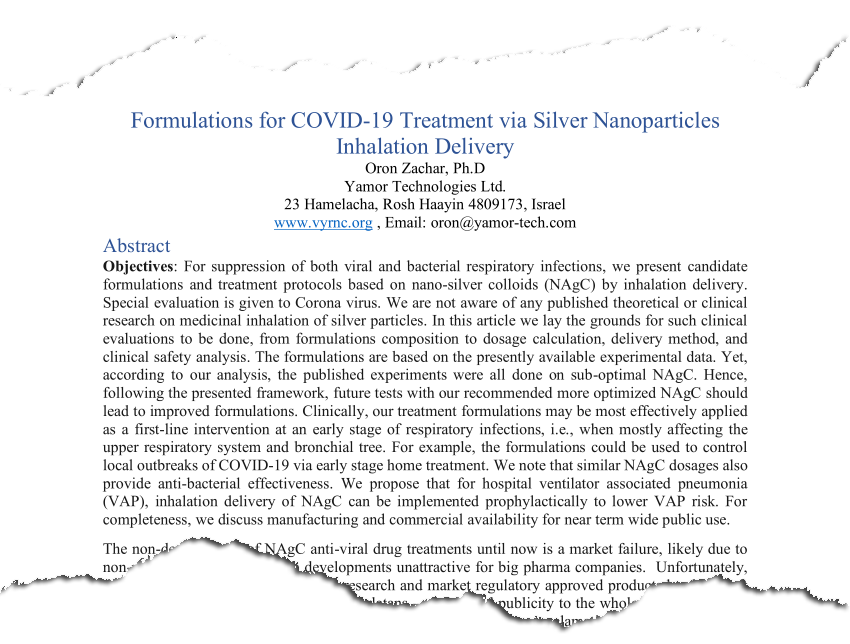Colloidal Silver is a broad term for a solution that contains various concentrations of microscopic ionic silver compounds, silver colloids, or silver compounds bound to protein in water. The word “Nano” simply refers to the size of the silver particles.
For many centuries, colloidal silver has been used by many different cultures as a natural preservative and disinfectant. The Phoenicians used silver jars to store their water and oils, which would create a colloidal solution slowly without the need for electrolysis and keep the liquids fresh for long periods of time. Hippocrates was an advocate of adding ground silver to water for disinfection and consumption. Some of our recent ancestors put silver spoons and coins into their milk before the advent of pasteurization and refrigeration for the same benefit. More recently, colloidal silver is added as a disinfectant to the water supplies of the Russian space station Mir and the International Space Station. The World Health Organization claims silver is an effective way to disinfect drinking water in third-world countries.

![]() Trumer Nano Ionic Hydrosol Skin Recovery Mist - 14
Trumer Nano Ionic Hydrosol Skin Recovery Mist - 14 
![]() Trumer Nano Ionic Hydrosol Skin Moisturiser - 10
Trumer Nano Ionic Hydrosol Skin Moisturiser - 10 
![]() Nano Hydrosol c/w NeilMed Sinugator
Nano Hydrosol c/w NeilMed Sinugator 
![]() TruCare Sinus Rinse Basic Kit
TruCare Sinus Rinse Basic Kit 
Or get it outside TrumerX at:

![]() https://shopee.com.my/search?keyword=colloidal%20silver
https://shopee.com.my/search?keyword=colloidal%20silver


Objectives: For suppression of both viral and bacterial respiratory infections, we present candidate formulations and treatment protocols based on nano-silver colloids (NAgC) by inhalation delivery. Special evaluation is given to Corona virus. We are not aware of any published theoretical or clinical research on medicinal inhalation of silver particles. In this article we lay the grounds for such clinical evaluations to be done, from formulations composition to dosage calculation, delivery method, and clinical safety analysis. The formulations are based on the presently available experimental data. Yet, according to our analysis, the published experiments were all done on sub-optimal NAgC. Hence, following the presented framework, future tests with our recommended more optimized NAgC should lead to improved formulations. Clinically, our treatment formulations may be most effectively applied as a first-line intervention at an early stage of respiratory infections, i.e., when mostly affecting the upper respiratory system and bronchial tree. For example, the formulations could be used to control local outbreaks of COVID-19 via early stage home treatment. We note that similar NAgC dosages also provide anti-bacterial effectiveness. We propose that for hospital ventilator associated pneumonia (VAP), inhalation delivery of NAgC can be implemented prophylactically to lower VAP risk. For completeness, we discuss manufacturing and commercial availability for near term wide public use.
The non-development of NAgC anti-viral drug treatments until now is a market failure, likely due to non-patentability, making such developments unattractive for big pharma companies. Unfortunately, the gap between promising academic research and market regulatory approved products has been left to be filled by “alternative medicine” charlatans – giving bad publicity to the whole field. In order to overcome this market failure situation, this article also serves as a proclamation and blueprint for an open-source drug development program to realize it. Potential development parties – academic, clinical, manufacturing, and commercial – are invited to join via the dedicated website noted in our address.
Method: We analyse: (a) nanoparticle size and material composition options, with special attention to the stabilization (capping) choice of materials, (b) the required effective inhibitory concentration (IC) in target respiratory system tissue, (c) the delivery method and associated treatment dosages. Building towards potential clinical evaluation, we discuss the evidence for safety of the proposed treatment based on published tests and guidelines in the EU and USA for inhalation of silver nanoparticles.
Results: The dosage is highly sensitive to the silver nanoparticle size, with 3nm - 7nm being the optimal size, significantly smaller then the ~10nm size of all the best experiments published in the literature. Hence, there is a potential for even better efficacy and/or lower dosage with our recommended NAgC. In manufacturing, PVP stabilization should be avoided, as it lowers the NAgC anti-viral effectiveness significantly, thus effectively requiring higher dosages (but is still fine for anti-bacterial applications). Effective anti-viral inhibitory concentration (IC) of 10μg/ml is estimated as a reasonable target concentration to achieve in the mucus fluid of the respiratory system. With colloidal silver of 5nm particles, delivering inhalation of standard 5μ diameter droplets aerosol (e.g., using off-the-shelf ultrasonic mesh nebulizers), we assert that IC can be achieved with depositing a total of just 0.33cc of a 30μg/ml NAgC concentration in the bronchial tree. Yet, after accounting for effective deposition fraction (~30%) and due to the fact that active inhalation time is just about 1/3 of the breathing cycle (if common continuous nebulizers are used, rather than breath-activated), a dosage of 3.3ml needs to be continuously nebulized for inhalation by the user. We recommend that exhalation through the nose can be implemented as a method to deliver the exhaled fraction of NAgC also to the nasal cavity when the nebulized inhalation is done orally. The required formulations are presently not available on the market but are easy to mass produce in principle. Using off-the-shelf ultrasonic nebulizers and providable OTC colloidal silver formulations, we posit that our suggested method can be used precautionarily at home by anyone feeling the early signs of a potential infection. In addition, due to the anti-bacterial properties of colloidal silver, at similar dosages to the anti-viral formulations, our method can serve in hospital intensive care units (ICU) as a new standard of care prophylactic treatment for ventilator acquired pneumonia (VAP). One of the main factors affecting inhalation antimicrobial delivery is the disease state. Increased mucus production would dilute the drug concentration compared with theoretical estimation based on the available healthy lung mucus volume data. Consequently, as common in antibiotic clinical inhalation therapy, effective treatment dosages are significantly higher than the in- vitro minimal IC (MIC). Early intervention, before significant additional mucus volume is produced, require lower and more predictable effective dosage. Luckily, for inhalation of NAgC formulations, there is a factor of more than 100x between our theoretically computed MIC and any estimated safety limit in the regulatory literature. Hence, clinical exploration of higher dosages is open for research.
Full research's link: https://www.researchgate.net/publication/340270205_Formulations_for_COVID-19_Treatment_via_Silver_Nanoparticles_Inhalation_Delivery